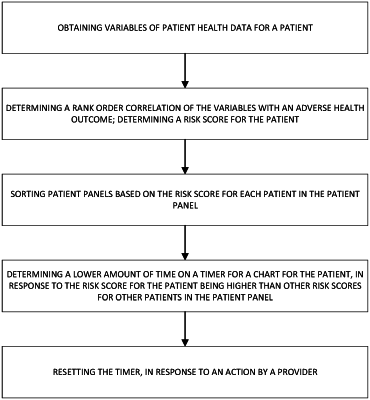| CPC G16H 10/60 (2018.01) [G16H 50/30 (2018.01)] | 20 Claims |

|
1. A method comprising:
receiving, by a computer, variables of patient health data for each patient within a panel of patients for one or more medical providers, wherein the variables comprise lab values and vital signs;
determining, by the computer, a likelihood of an adverse health outcome based on at least one of a likelihood of hospitalization of each patient within the panel of patients within a time period, a likelihood of a fall sustained by each patient within the panel of patients within the time period or a likelihood of a death of each patient within the panel of patients in the time period;
determining, by the computer using the multi-attribute value function, a first rank order correlation of the lab values common to a subset of the patients within the panel of patients for the one or more medical providers, with the likelihood of the adverse health outcome for each patient within the panel of patients for the one or more medical providers, wherein the first rank order correlation determines a statistical dependence between a ranking of the lab values and the likelihood of the adverse health outcome for the panel of patients;
determining, by the computer using the multi-attribute value function, a second rank order correlation of the vital signs common to the subset of the patients within the panel of patients for the one or more medical providers, with the likelihood of the adverse health outcome for each patient within the panel of patients for the one or more medical providers, wherein the second rank order correlation determines a statistical dependence between a ranking of the vital signs and the likelihood of the adverse health outcome for the panel of patients;
determining, by the computer using the multi-attribute value function, a risk score for the patient based on the first rank order correlation, the second rank order correlation and a weighting of the panel of patients;
sorting, by the computer, the panel of patients based on the risk score for each patient in the panel of patients;
lowering, by the computer, a timeframe to a lowered timeframe on a timer for allocating healthcare resources for the patient, in response to the risk score for the patient being higher than other risk scores for other patients in the panel of patients; and
setting, by the computer, the timer for the lowered timeframe, in response to the allocating the healthcare resources.
|